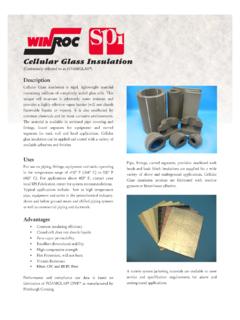Transcription of glass etching instruction
1 #99-9154 RIllustrated Guide tothe World of Creative glass Project Ideas Detailed instructions Create Your Own StencilsFeaturing:The ARMOUR ETCH glass etching SystemYou are about to create Professional Quality permanent etched designs using 3 easy steps in less then 5 minutes!MATERIALS NEEDED: Ruler Masking Tape glass Cleaner Paper Towels Water Source Hobby Knife Cotton Swabs Steel Wool Gloves Lint-free Cloth Pen, Pencil, Eraser Carbon Paper (smudge proof) Protective Glasses or Goggles Newspaper or Plastic Drop Cloth Long Sleeve Garment or Apron Additional Patterns & Designs Contact Brand Shelving VinylImportant InformationPlease Read the following Safety Precautions:Neither seller nor manufacturer shall be liable for any injury, loss or damage, direct or consequential, arising out of the use of or the ability to use the product. Before using, user shall determine the suitability of the product for the intended use and assume all risks and liabilities in connection contains ARMOUR ETCH glass etching Cream, KEEP OUT OF REACH OF CHILDREN & PETSC ontains: Ammonium and Sodium contact with eyes & skin.
2 Do not taste, swallow or breathe liquid or mist. Always use near water. Use in well ventilated area. Wear long sleeve protective garments, rubber or plastic gloves & protective glasses or goggles. Rinse empty container thoroughly with water before discarding in proper receptacle. Contains fluorides. Use only under adult supervision. First Aid: Call physician : Wash with soapy water. Clean under : Give large quantity of water and follow with mineral oil or egg : Flush with water for 15 Emergency information call the Poison Control Center 1 (800) 222-1222 Contains glass , which may break exhibiting sharp edges. Conforms to ASTM D-4236 Ages 18 and : Armour Etch Cream will not etch plastics and some Pyrex. When in doubt, test the material before starting. Not intended to etch larger solid areas. Please read safety instructions on the Armour Etch glass etching Cream container before beginning your stencil design & applying to glass1.
3 Clean the glass or mirror thoroughly to remove all grease, dust and fi ngerprints. Avoid cleaner solutions that advertise Finger print resistant , as these cleaners leave a fi lm on the glass that hinders the etching process. Avoid fi nger prints on the glass where you are going to etch. Dry glass or mirror the glass or mirrorRemove top carrier sheet4. When the entire stencil has been adhered, carefully remove some of the masking tape and slowly peel back the clear top sheet. See Photo A2. If the stencil has not been totally adhered to the glass , put the top sheet back down and re-rub area until all pieces are Choose the design of your choice and carefully cut the stencil sheet and the frosted backing sheet together to avoid touching the back side of the stencil carefully to determine where you will locate the stencil on the glass or mirror. Separate the blue stencil sheet from the frosted backing sheet.
4 Put aside the frosted backing sheet to be used later. Place stencil sheet on the glass with the blue (tacky) side touching the glass . Secure stencil sheet temporarily to the glass with masking tape as shown in Photo A1. 3. Using the wood stick enclosed, transfer the stencil from the sheet to the glass surface by rubbing firmly over the design with smooth, even strokes. Rub left and right, then up and down. Do not dig into the stencil. You will be able to see the stencil being transferred by the change in color from a dark blue to a lighter blue see Photo A1. Be careful when you rub near the edge of the stencil not to peel it back up by Rub N Etch Stencils(Photo A1)5. Apply a border of masking tape around the entire stencil overlapping the tape on the blue stencil by 1/16 to 1/8 , being careful not to overlap the overlap prevents the etching cream from contacting the glass and etching unwanted areas!
5 If a very large area of glass needs to be protected, use strips of adhesive backed shelving vinyl. When all sides of the stencil have been taped, use the white frosted backing sheet to lightly rub over the entire stencil area. Check the stencil for small tears or holes by holding the project up to the light. If any holes appear, cover them with small pieces of tape. Be careful where you put the tape, because the stencil will tear if you try to remove the glass for etching 6. For best etching results we recommend that the room temperature, the etching cream temperature and the object you are etching be over 70 degrees. Shake the ARMOUR ETCH Cream thoroughly. Work in a well lighted and well ventilated area near a water source. Wear plastic gloves and protective eyewear. You must apply a thick layer of etching cream in order for the chemical to react properly on the glass or mirror.
6 Thick enough so that you cannot see the design of the stencil through the Armour Etch Cream. Stay within taped area. See Photo the Armour Etch creamUsing Rub N Etch Stencils(Photo A2)(Photo A3)(Photo A3)(Photo A2)7. Allow ARMOUR ETCH Cream to remain on glass for one minute No longer! Immediately wash off all the etching cream under luke warm water, see Photo A4. Some of the stencil will be removed during this rinse, but it s OK. After all traces of the etching cream are washed away, remove all the remaining tape and stencil pieces. Clean the glass using window cleaner and dry etching cream & stencilUsing Rub N Etch Stencils(Photo A4)Helpful Hint:The vinyl masking should be slightlylarger than your project so the vinyl can wrap around the edges of the the vinyl maskingTurn the sheet of vinyl masking over with the backing sheet facing up. Peel down about 1 of the backing sheet across the top of the vinyl.
7 Press down and crease the backing sheet to force it to lay flat, as shown in Photo B1. Turn the sheet of vinyl masking over so the adhesive side is facing the glass . Align the top edge of the vinyl with the top edge of the glass . Allow vinyl to overlap evenly all around. When aligned, press the exposed adhesive strip to adhere the vinyl to the glass . With one hand on top of the vinyl, rub from side to side to adhere it to the glass . With your other hand underneath, slowly pull to remove the backing sheet. See Photo B2. Press out the air bubbles as you go. If you miss a few, pull up the vinyl masking until the bubbles disappear, then continue rubbing from side to side until the vinyl is evenly applied. Fold the excess vinyl over the edges of the glass . Clean the glass or mirror (Refer to Rub N Etch instructions ). Cut the masking vinyl 1 larger than the length and width of your etching Stencil(Photo B1)(Photo B2)Transferring your design onto the vinyl maskingTechnique A: Trace your design.
8 Position your design in the desired location on the vinyl covered glass . Use a ruler to determine if your design is aligned on all sides. Tape only the top edge of the design sheet firmly to the masking vinyl. The design is taped only on the top edge so it may be lifted periodically to check how the design is transferring. Place a sheet of smudgeproof carbon paper face down under the design sheet and trace over the design with a ball point pen. See Photo B3. Use enough pressure to transfer the design but not so hard that you tear the design sheet. Upon completion of the tracing, lift up the design sheet and carbon paper to make sure all lines were transferred accurately. If so, then remove both tracing etching StencilSome helpful hints before you get started. Rubbing the masking vinyl gently with steel wool, before you trace your design, will give your tracing a darker impression.
9 The longer the vinyl masking remains on the glass , the better the adhesive sticks. We recommend using Contact Brand Shelving vinyl. Avoid using tape as a stencil. You should start with a simple design for your first glass etching project and gradually work up to more intricate patterns once you gain confidence and experience with the knife cutting techniques. Now let s get started!There are four techniques we use to transfer designs before they are cut by hand to create a custom glass etching stencil. (For this lesson you will be using technique A).Every design has several possibilities of how it can be cut out as a stencil and etched as shown in the following illustrations. You can choose to cut and etch only the outline of the design (Illustration A), or you may choose to cut and etch only the solid areas (Illustration B). Another alternative is to remove the background and reverse etch the area (Illustration C),which is only recommended for sandblasting.
10 If you are unsure as to which technique to use, take your original design sheet and use a pencil to shade in the areas you think would look good as an etched area or outlined the areas to be etchedCutting out the designCustom etching Stencil(Illustration A)(Illustration B)(Illustration C)Hold the hobby knife in your hand as you would a pen for writing. Rest the weight of your hand on the side of your palm and grip the knife handle firmly but not too tight. Slowly and smoothly, Technique B: Draw your design freehand. If you have artistic ability you can try your hand using a rounded pencil and light pressure to avoid tearing the C: Create a stencil from cardboard. Use a cardboard or plastic stencil to help guide your pencil. Good for repeat D: Use a photocopy of your design. Use a copy machine to duplicate your design. Then coat the back of the photocopy with spray adhesive and adhere the design to the etching Stencil(Photo B4)(Photo B3)pull the knife along the side of the line using just enough pressure to cut through the vinyl, but not so much as to scratch the sure your blade is sharp.





